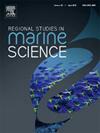生物和非生物因素对渔业资源保护区中层浮游生物和鱼类幼虫群落结构的影响:韩国江津湾案例研究
IF 2.1
4区 环境科学与生态学
Q3 ECOLOGY
引用次数: 0
摘要
本文章由计算机程序翻译,如有差异,请以英文原文为准。
Influence of biotic and abiotic factors on mesozooplankton and fish larvae community structures in a fisheries resource protected area: A case study of Gangjin Bay, Korea
Mesozooplankton and fish larvae are critical components of aquatic food webs, and their community structure is essential for effective fisheries management. However, since 1999, no data on these communities have been recorded in Gangjin Bay, Korea, a designated Fisheries Resources Protected Area and a crucial spawning and nursery ground for various fish species. This study investigated the community structure of mesozooplankton and fish larvae in Gangjin Bay from March to November 2022 through monthly sampling. In spring, Noctiluca scintillans dominated, while copepods and cirripedian larvae prevailed in summer and autumn, respectively. The biotic and abiotic factors influencing the community structure of Paracalanus orientalis and Acartia ohtsukai included water temperature and concentrations of chlorophyll a in the micro- and pico-fractions. The biotic and abiotic factors influencing the community structure of anchovy and goby larvae included the abundance of P. orientalis and A. ohtsukai, while those affecting Sebastes inermis larvae were influenced by the abundance of Calanus sinicus and mesozooplankton biomass, particularly in the 1.0-mm size class. This study provides baseline data to describe the community structure of mesozooplankton and fish larvae in Gangjin Bay, thereby contributing to the development of policies for fisheries resource protection and management.
求助全文
通过发布文献求助,成功后即可免费获取论文全文。
去求助
来源期刊

Regional Studies in Marine Science
Agricultural and Biological Sciences-Ecology, Evolution, Behavior and Systematics
CiteScore
3.90
自引率
4.80%
发文量
336
审稿时长
69 days
期刊介绍:
REGIONAL STUDIES IN MARINE SCIENCE will publish scientifically sound papers on regional aspects of maritime and marine resources in estuaries, coastal zones, continental shelf, the seas and oceans.
 求助内容:
求助内容: 应助结果提醒方式:
应助结果提醒方式:


